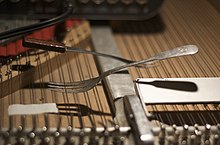Anunpitched percussion instrument is a percussion instrument played in such a way as to produce sounds of indeterminate pitch, or an instrument normally played in this fashion.


Unpitched percussion is typically used to maintain a rhythm or to provide accents, and its sounds are unrelated to the melody and harmony of the music. Within the orchestra, unpitched percussion is termed auxiliary percussion, and this subsection of the percussion section includes all unpitched instruments of the orchestra however they are played, for example the pea whistle and siren.
A common and typical example of an unpitched instrument is the snare drum, which is perceived as unpitched for three reasons:
The snare drum illustrates the three main ways in which a sound can be perceived as indeterminate in pitch:
In practice, two or all of these mechanisms are frequently in effect in producing the sensation of an instrument being unpitched, but any one can be sufficient.
Many unpitched percussion instruments do, or can, produce a sound with a recognisable fundamental frequency, and so can also be used as pitched percussion. The pitch of a bell is particularly strong however struck. The sound of a floor tom played with normal drumsticks is inharmonic, but the same drum played with the mallets and in the fashion of a timpani can produce a recognisable pitch, without requiring any retuning.

More radically, pitched instruments can be used to produce unpitched sounds, for example a prepared piano, or the golpe technique of flamenco music.
This section does not cite any sources. Please help improve this sectionbyadding citations to reliable sources. Unsourced material may be challenged and removed. (February 2023) (Learn how and when to remove this message)
|
Within a set of unpitched percussion instruments, there is commonly a sense of higher and lower pitch, for example:
These pitches however:
If either of these two conditions is not met, then the instrument could be considered pitched.
Many folk instruments and world music instruments are tuned to match the pitch of a particular degree of the scale of the music, including:
These harmonic relationships may or may not be understood by the players themselves, but are consistently produced by skilled performers within the tradition,[citation needed] and this skill in tuning is passed on to their students. Failure to recognise these relationships is a common cause for such instruments sounding bad in the hands of beginners and players from other traditions, when heard by those familiar with the tradition.
Instruments regularly used both as pitched and as unpitched percussion include many types of bells. Lincoln Cathedral, for example, has three bell towers, two containing bells used as unpitched including a chiming clock, and the third containing a pitched ring of bells.
Traditionally, unpitched percussion instruments are referred to as untuned percussion, and this remains a common concept and term, and a common name for the auxiliary percussion subsection of the percussion section of the orchestra. However, the terms tuned percussion and untuned percussion are avoided in recent organology, for two main reasons: